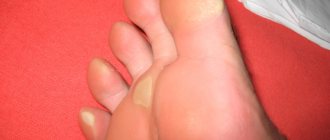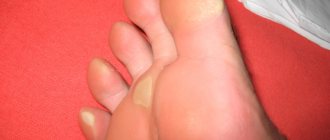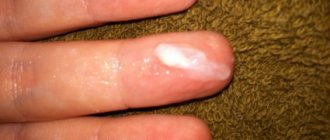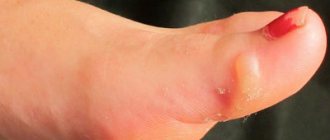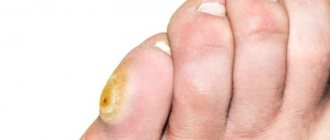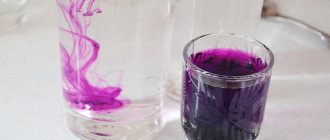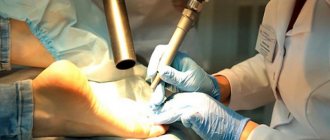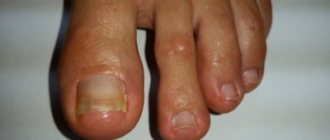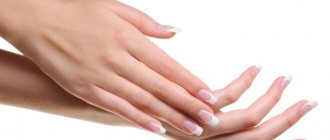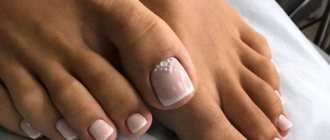Each person rubbed his feet. A callus is a protective reaction of the body that prevents the skin from being abraded to the deep layers of the epidermis. Most often they appear on the feet due to wearing tight, uncomfortable shoes; a new pair of shoes can also bring discomfort and pain. The neoplasm itself is not dangerous, but if the callus festers, you should consult a doctor to avoid infection.
Signs of infection
There are water and blood calluses. They differ in their contents: the first are filled with a clear liquid, the second, purple in color, with blood. Any of them can fester. An infected callus requires immediate treatment; it is recommended to immediately consult a specialist to prevent the occurrence of blood poisoning and prevent the infection from spreading throughout the body. Most often, inflammation of the callus is observed on the toe and heel due to wearing tight shoes.
The main symptoms of callus suppuration:
- Change in color of exudate (liquid in the callus),
- The appearance of redness and inflammation around the callus,
- Discharge of pus
- Sharp pain when touched
- There may be a slight increase in body temperature.
If you notice that a callus is festering, then take action immediately!
3. Symptoms and diagnosis
There are several types of calluses, which differ significantly both etiologically and clinically. For example, a core callus is usually formed in response to the introduction of a small foreign body (a splinter, a chip that has gotten under the skin, a piece of stone, etc.) and is a compaction that goes deep, visible from the outside as a cap with a central crater. Corns are also a type of callus - keratinized areas on the soles of the feet, sometimes of a fairly large area, without a clear boundary with the skin of normal elasticity and moisture.
The most obvious and significant difference is between the two main categories of calluses: soft and dry.
Soft (water) calluses at the stage of formation are a locally irritated, reddened, weeping, painful area of skin, which quickly transforms into a blister or sac filled with serous fluid (“dropsy”); if the exposure does not stop at this stage, the soft callus inevitably breaks through to form an open wound. The penetration of pathogenic microorganisms triggers an infectious-inflammatory process, the classic signs of which are swelling, hyperemia, clearly localized pain, and local fever. The most serious of the complications mentioned above include purulent abscesses, cellulitis, and osteomyelitis.
The callus is dry (hard), looks like a local rounded keratinization, usually yellow-gray, with a radius of several millimeters to several centimeters, clearly demarcated from the surrounding skin and rising (sometimes significantly) above its level. Any pain or discomfort occurs, as a rule, only when such a callus is pressed or laterally displaced.
The most common areas for the formation of calluses are the distal, terminal sections of the hands and feet (phalangeal folds, fingertips, interdigital spaces, skin of the palms and soles), as well as elbows and knees. More specific calluses can also occur in other areas: for example, in professional violinists, constant contact with the hard varnished wood of the soundboard causes the skin on the lower jaw bone on the left to become rough.
As a rule, there is no need for additional diagnostics: a dermatologist or surgeon at first glance distinguishes a callus from an inflammatory cyst or abscess, scleroderma skin changes, warts, swelling due to joint inflammation, etc. However, in some cases, a differential diagnostic study (for example, histological or ultrasound) may be necessary.
About our clinic Chistye Prudy metro station Medintercom page!
Mechanism of infection
A callus with pus most often appears when the blister is not treated and antiseptic rules are not followed when treating it. An open callus is a gateway to infection, so it must be isolated from the surrounding aggressive environment.
Purulent exudate (liquid inside the callus) consists of dead leukocytes that protect the body from pathogenic bacteria and dangerous infections. Its appearance indicates that the immune system is working properly. But in our body there is a single network of blood vessels, thanks to which oxygen and nutrients reach the organs and tissues. The same transport system can lead to the spread of infection, which can lead to sepsis (blood poisoning), embolism (blockage of blood vessels) and gangrene.
What to do with hard calluses?
A hard callus is essentially a dry callus.
Naturally, you need to get rid of it.
Let's take a closer look at some official pharmaceutical products for the treatment of calluses.
Treated with Anticorn Super cream.
It is used to moisturize and gradually soften.
It contains many natural plant components with bactericidal and softening properties.
They are also treated with the oily liquid “Feresol” with a cauterizing effect due to the content of phenol and tricresol.
It also has antimicrobial, anti-inflammatory, bactericidal and softening effects.
They are also treated with a very effective remedy - Roacutane gel.
This gel has a keratolytic effect.
Due to the content of salicylic, lactic, boric, benzoic and citric acids in its composition.
And finally, a few words about the Salipoda patch.
This convenient patch has long proven its effectiveness.
It has a pronounced softening antimicrobial effect.
But before using these products, you must carefully re-read all contraindications and strictly adhere to them.
Treatment with professional methods
It is recommended to ask your doctor how to treat a purulent callus. This disease is dealt with by specialists in purulent surgery; only a professional will be able to properly open and drain a festering blister in order to prevent infection. If improperly processed and incompletely pumping out the contents, purulent calluses can recur, and the infection can spread through the blood vessels throughout the body. After the procedure, broad-spectrum antibiotics are prescribed to prevent infection.
Callus hurts: how to remove and where to remove
Today, there are various ways to get rid of calluses and corns.
They use special tools and devices.
Various techniques are used:
- surgical excision;
- removal using a special device with grinding attachments (cutters);
- cryodestruction (freezing with liquid nitrogen);
- using a laser beam.
The most effective, reliable and safe method is considered to be using laser technology.
Using a carbon dioxide laser beam, the keratinized epithelial layer is evaporated layer by layer without damaging healthy skin.
The main advantages of using a laser to remove calluses are:
- the presence of bloodlessness and complete sterility, since the laser beam causes a bactericidal effect;
- when removing calluses (at one time), scars and other defects do not form;
- rapid rehabilitation (after surgical interventions you can immediately “be in service”).
Such removal can be carried out in specialized offices and clinics where there is the necessary equipment and specialists.
Self-treatment
Not everyone has the opportunity to see a doctor right away, so many people ask the question: “A callus on my foot has festered, what should I do?” In the first days of the development of the disease, you can try to solve the problem yourself, using medications or folk recipes.
Medications
When you detect the first signs of the disease, you need to know what to do if the callus is inflamed. Doctors recommend using Vishnevsky ointment or Levomekol. To do this, you need to apply a thick layer of the selected drug to the festering area, then seal it with a band-aid or wrap it with a sterile bandage for a day. It is advisable to keep your foot at rest for the duration of treatment; you should not wear tight shoes. The dressing is changed twice a day. The next day the pus should come out.
When changing the dressing, the purulent callus is treated with hydrogen peroxide, furacillin or chlorhexidine.
Folk recipes
You can try treating an infected callus using home recipes. These techniques are simple and effective, and the ingredients for them are available in every home.
A leaf of aloe, peeled and tied to the sore spot overnight, is good at drawing out pus. Lemon pulp will also help get rid of suppuration if applied overnight. In the morning, you need to rinse your leg with warm water and apply a bandage.
Try a salt compress to get rid of the callus. Dissolve 1-1.5 tbsp. in 1 glass of water, moisten a swab or cotton wool and apply to the blister for 2-3 hours. The mixture softens the skin, stimulating the removal of exudate. The procedure can be combined with the use of anti-inflammatory ointments, repeating them 2-3 times a day.
The onion peel tincture is prepared simply: onion peels are infused in vinegar for 7 days, then they are taken out and applied overnight to the affected area.
If the callus is festered and swollen, foot baths can help. For their preparation, ingredients that are found in every home are used.
- Pour warm water over baking soda (3 tsp) and baby soap (1 tbsp), and soak your feet in the mixture for 30 minutes. This recipe will help relieve inflammation and soften rough skin.
- Salt baths reduce pain and swelling. To prepare them, table or sea salt dissolved in warm water is used. The duration of the procedure is 20-30 minutes.
Important:
Any of the listed remedies should be used no more than 48 hours after the appearance of a festering blister. If home therapy for an infected callus does not produce any results, then you need to seek help from a specialist, only he can help get rid of the disease without consequences.
How to reduce inflammation
If a callus breaks out, you should not self-medicate. Inflammation is eliminated by puncture, which is done in a hospital. The doctor performs drainage, suctioning fluid from the swollen tumor. Next, an antiseptic bandage is applied and antibacterial drugs are prescribed. The patient is discharged home, recommended to change the dressings at least 2 times a day. Whenever you change the dressing, you first need to treat the wound with an antiseptic (chlorhexidine bigluconate, hydrogen peroxide, furatsilin), and then apply an antimicrobial wound-healing ointment.
A dry growth can also fester. If the callus is inflamed, the following means of eliminating it are used:
- removing the rod with liquid boron and treating with an antiseptic;
- laser treatment is a painless, effective procedure, the lesion will heal in a maximum of 5 days;
- cryotherapy - “freezing” with liquid nitrogen, healthy tissue is not affected.
We recommend reading
- Ointments for healing calluses on feet: review of the best
- What to do if a callus bursts on your foot
- Antibiotics for erysipelas: how to treat, what to take
Tips to avoid infection
A purulent callus requires long-term and unpleasant treatment, so it is better to avoid its appearance. To do this, just follow these simple tips:
- Choose comfortable shoes and socks of the appropriate size,
- Give preference to shoes made from natural materials, do not wear synthetic socks,
- Pay attention to the health of the skin on your feet: lubricate with Vaseline the places most susceptible to rubbing calluses.
- If a blister appears, do not neglect treatment: be sure to treat it, cover it with a band-aid to prevent infection,
- Watch your weight - obese people have a higher risk of developing purulent calluses.
The appearance of pus is the body’s protective reaction to infection, but if the callus festers, it is advisable to immediately consult a specialist. If it is not possible to visit a specialist, then you can use medication and folk methods to eliminate the blister. Home therapy is carried out for no more than 2 days; if a positive trend is not observed, then you need to consult a doctor to prescribe treatment. An infected callus can lead to blood poisoning, blockage of blood vessels, and even gangrene.
Interdigital calluses
Sometimes calluses appear in the spaces between the toes on the feet, less often on the hands.
They cause a feeling of great discomfort.
People around them practically do not see them, but they are very painful.
Interdigital calluses are wet calluses.
The interdigital spaces (thumb and second finger, as well as the ring and little fingers) are favorite places for calluses to localize.
Interdigital calluses are common at any age, for both men and women.
Essentially, callus is an adaptive response of the epidermis to prolonged friction or compression.
In which layers of keratinized epidermis are actively built up at the site of mechanical action.
The causes of calluses between the toes are:
- uncomfortable and tight shoes;
- high heels;
- presence - flat feet;
- finger deformities;
- overweight;
- joint diseases (arthrosis, arthritis or gout);
- swelling of the legs.

